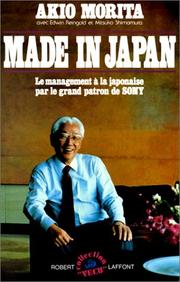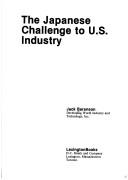| Listing 1 - 10 of 12 | << page >> |
Sort by
|
Book
ISBN: 9782251451268 2251451269 Year: 2021 Volume: 42 Publisher: Paris: Les Belles Lettres,
Abstract | Keywords | Export | Availability | Bookmark
 Loading...
Loading...Choose an application
- Reference Manager
- EndNote
- RefWorks (Direct export to RefWorks)
Comment expliquer les origines de l'impressionnant développement économique japonais au cours du XXe siècle ? Alors que les thèses habituellement avancées soulignent le rôle du pouvoir central (gouvernement et zaibatsu), Nakamura Naofumi nous fait parcourir le Japon de l'ère Meiji (1868-1912) dans toute son étendue, du nord au sud, à la découverte des fondations régionales de la « Révolution industrielle ». Analysant la mentalité des acteurs, leur capacité à l'échange d'informations, à l'activation de réseaux de proximité, à la mobilisation de capitaux, l'auteur décrit une pléthore d'entrepreneurs et d'agents publics locaux dynamiques. Engagés dans le lancement d'entreprises innovantes de dimension régionale, ils réalisèrent des aménagements industriels (filatures, charbonnages, chemin de fer ou secteur électrique) dans tout l'archipel entre les années 1880 et 1900. À l'heure où la désindustrialisation des régions s'accompagne d'une croissance économique en berne, la démonstration de Nakamura Naofumi n'apparaît que plus riche de sens.
Industrial revolution --- Industries --- History --- J4300.80 --- J4400 --- Japan: Economy and industry -- history -- Gendai (1926- ), Shōwa period, 20th century --- Japan: Economy and industry -- industry and enterprise --- Industrial revolution - Japan. --- Industries - Japan - History - 19th century. --- Industries - Japan - History - 20th century.
Book
ISBN: 0709902077 0873321529 9780709902072 9780873321525 Year: 1980 Publisher: White Plains (N.Y.): Sharpe,
Abstract | Keywords | Export | Availability | Bookmark
 Loading...
Loading...Choose an application
- Reference Manager
- EndNote
- RefWorks (Direct export to RefWorks)
Industrial economics --- Japan --- Industrial organization --- Industrial organization (Economic theory) --- Industrial policy --- Big business --- Industries --- 658.11 --- Kinds and forms of enterprise --- 658.11 Kinds and forms of enterprise --- Industrial organization - Japan --- Industrial policy - Japan --- Big business - Japan --- Industries - Japan

ISBN: 2713208459 9782713208454 Year: 1985 Volume: 14 Publisher: Paris : Ecole des hautes études en sciences sociales,
Abstract | Keywords | Export | Availability | Bookmark
 Loading...
Loading...Choose an application
- Reference Manager
- EndNote
- RefWorks (Direct export to RefWorks)
Electronic industries --- Management --- Personnel management --- J4350.10 --- J4351 --- J4360 --- J4452 --- -Electronic industries --- -331-057.4 <52> --- 316.343.653 <52> --- 658 <520> --- Electronics industry --- Electric industries --- Japan: Economy and industry -- labor and employment -- policy, legislation, guidelines, codes of behavior --- Japan: Economy and industry -- labor and employment -- labor and employment systems --- Japan: Economy and industry -- business methods and management --- Japan: Economy and industry -- manufacturing and production -- high-tech --- Management. --- Personnel management. --- 331-057.4 <52> --- Cadres d'entreprises. Japon. --- Kaderpersoneel. Japan. --- Electronic industries - Japan - Management --- Electronic industries - Japan - Personnel management

ISBN: 2221051696 9782221051696 Year: 1986 Publisher: Paris: Laffont,
Abstract | Keywords | Export | Availability | Bookmark
 Loading...
Loading...Choose an application
- Reference Manager
- EndNote
- RefWorks (Direct export to RefWorks)
Industrialists --- Electronic industries --- Biography. --- History. --- Morita, Akio, --- Sonī Kabushiki Kaisha --- S35/0580 --- S35/0700 --- #SML: Euntes --- 929 MORITA, AKIO --- management --- biographies --- japon --- Japan--Biographies --- Japan--Economy --- biografieen --- japan --- Industrialists - Japan - Biography. --- Electronic industries - Japan - History. --- Morita, Akio, - 1921 --- -960 --- 960 --- levensbeschrijvingen --- biographies et mémoires --- -S35/0580 --- -Industrialists --- Morita, Akio, - 1921-

ISBN: 0669044024 9780669044027 Year: 1981 Publisher: Lexington (Mass.): Lexington books,
Abstract | Keywords | Export | Availability | Bookmark
 Loading...
Loading...Choose an application
- Reference Manager
- EndNote
- RefWorks (Direct export to RefWorks)
Industries --- Japan --- United States --- Commerce --- J4410 --- J4360 --- J4544.10 --- Japan: Economy and industry -- industrial organization and relations --- Japan: Economy and industry -- business methods and management --- Japan: Economy and industry -- commerce and trade -- international trade, economic relations and policy -- North America --- Industries - Japan --- Industries - United States --- Japan - Commerce - United States --- United States - Commerce - Japan

ISBN: 0815713231 081571324X 9780815713234 9780815713241 Year: 1976 Publisher: Washington (D.C.) : Brookings institution,
Abstract | Keywords | Export | Availability | Bookmark
 Loading...
Loading...Choose an application
- Reference Manager
- EndNote
- RefWorks (Direct export to RefWorks)
Big business --- Industries --- Industrial efficiency --- Japan --- Economic conditions --- 658.11 <520> --- J4410 --- Kinds and forms of enterprise--Japan --- Japan: Economy and industry -- industrial organization and relations --- 658.11 <520> Kinds and forms of enterprise--Japan --- Big business - Japan. --- Industries - Japan. --- Industrial efficiency - Japan. --- Japan - Economic conditions - 1945 --- -Big business
Book
ISBN: 0801494621 0801420229 9780801494628 9780801420221 Year: 1987 Publisher: Ithaca: Cornell university press,
Abstract | Keywords | Export | Availability | Bookmark
 Loading...
Loading...Choose an application
- Reference Manager
- EndNote
- RefWorks (Direct export to RefWorks)
J4420 --- J4301 --- J4415 --- Energy industries --- -Industrial policy --- -Business --- Industries --- Industry and state --- Economic policy --- Power resources --- Japan: Economy and industry -- resource industry --- Japan: Economy and industry -- policy, legislation, guidelines, codes of behavior --- Japan: Economy and industry -- industrial organization and relations -- industry and state --- Government policy --- Industrial policy --- -Japan: Economy and industry -- resource industry --- Energy industries - Japan --- Industrial policy - Japan

ISBN: 0521413869 9780521413862 9780511520723 9780521061063 0521061067 0511520727 051183313X 0511002645 Year: 1992 Volume: 18 Publisher: Cambridge: Cambridge university press,
Abstract | Keywords | Export | Availability | Bookmark
 Loading...
Loading...Choose an application
- Reference Manager
- EndNote
- RefWorks (Direct export to RefWorks)
The management of buyer-supplier relations has come to be regarded as a key to achieving manufacturing competitiveness, particularly in sectors facing global competition based on both price and quality. This book is a theoretical and empirical exploration of the link between the type of buyer-supplier relations and corporate performance. Dr Sako examines how British and Japanese companies in the electronics industry manage their relationships with buyers and suppliers, the empirical study comprising a three-way comparison of a Japanese customer company, a British customer company, and a Japanese company in Britain, and an analysis of 36 supplier companies in Britain and Japan. Variations of the companies' business practices are assessed in terms of technology, the nature of market competition, the national legal framework, financial structures, employment systems, and the mode of entrepreneurship. The author identifies two distinct approaches in the two countries - the arm's-length contractual relation (ACR) in Britain, and the obligational contractual relation (OCR) in Japan - and argues that the trust and interdependence present in the latter can be a powerful springboard from which to achieve corporate success.
Industrial procurement --- Electronic industries --- Cross-cultural studies. --- J4360 --- J4410 --- Buyer-supplier relations --- Buying, Industrial --- Industrial buying --- Industrial equipment --- Industrial purchasing --- Procurement, Industrial --- Purchasing, Industrial --- Supplier-buyer relations --- Industrial management --- Purchasing --- Electronics industry --- Electric industries --- Japan: Economy and industry -- business methods and management --- Japan: Economy and industry -- industrial organization and relations --- Production --- Management --- Great Britain --- Japan --- Cross-cultural studies --- Industrial procurement - Japan. --- Industrial procurement - Great Britain. --- Industrial procurement - Cross-cultural studies. --- Electronic industries - Japan. --- Electronic industries - Great Britain. --- Business, Economy and Management --- Business Management

ISBN: 4538760064 9784538760063 Year: 2000 Volume: 6 Publisher: Tokyo: Japan Institute of Labour,
Abstract | Keywords | Export | Availability | Bookmark
 Loading...
Loading...Choose an application
- Reference Manager
- EndNote
- RefWorks (Direct export to RefWorks)
Industries --- Labor --- History --- Japan --- Economic conditions --- #SBIB:95G --- #SBIB:328H53 --- #SBIB:316.334.2A418 --- J4350.80 --- J4300.90 --- Geschiedenis van Azië (inclusief Arabische wereld, Nabije Oosten) --- Instellingen en beleid: Japan --- Arbeidssociologie: de vakbeweging in niet-Europese landen --- Japan: Economy and industry -- labor and employment -- history --- Japan: Economy and industry -- history -- postwar Shōwa (1945- ), Heisei period (1989- ), contemporary --- Industries - Japan - History --- Labor - Japan - History --- Japan - Economic conditions - 1945 --- -Industries
Book
ISBN: 4431539131 443154108X Year: 2012 Publisher: Tokyo : Springer,
Abstract | Keywords | Export | Availability | Bookmark
 Loading...
Loading...Choose an application
- Reference Manager
- EndNote
- RefWorks (Direct export to RefWorks)
Since the last century, ceramics have become essential to modern society and our daily lives. They have become an indispensable product to many industries, especially within the fields of electronics, automobiles, medicine, and leisure. Japanese ceramic technologies and products are highly sophisticated and world renown, and ceramic products have long contributed to Japanese society. The true significance of ceramics to modern society however, is not well understood. This book describes in detail the background to and objective of the development, materials, manufacturing processes, functions and future prospects of a number of ceramic products. Not merely about the science and technology of ceramic manufacturing, the book is about the products themselves, as it tries to clarify how ceramics continue to contribute to our lives. It is the first such work to show advanced ceramic products in detail, from the technologies used to their application, and can be seen as a kind of illustrated reference book for modern advanced ceramic products as it is filled with easy-to-understand illustrations and photos. By including past and current product technologies, the editors hope the book will serve to guide engineers and the manufacturing sector toward a bright future of innovations for the benefit of us all.
Ceramic industries -- Japan. --- Ceramic materials -- Japan. --- Ceramics -- Japan. --- Ceramics --- Chemical & Materials Engineering --- Engineering & Applied Sciences --- Materials Science --- Chemical Engineering --- Ceramic industries --- Ceramic materials --- Ceramic technology --- Industrial ceramics --- Keramics --- Materials --- Materials science. --- Chemical engineering. --- Industrial engineering. --- Materials Science. --- Ceramics, Glass, Composites, Natural Methods. --- Industrial Chemistry/Chemical Engineering. --- Operating Procedures, Materials Treatment. --- Mines and mineral resources --- Building materials --- Chemistry, Technical --- Clay --- Manufactures. --- Ceramics, Glass, Composites, Natural Materials. --- Manufacturing, Machines, Tools, Processes. --- Manufactured goods --- Manufactured products --- Products --- Products, Manufactured --- Commercial products --- Manufacturing industries --- Chemistry, Industrial --- Engineering, Chemical --- Industrial chemistry --- Engineering --- Metallurgy --- Ceramics. --- Glass. --- Composites (Materials). --- Composite materials. --- Composites (Materials) --- Multiphase materials --- Reinforced solids --- Solids, Reinforced --- Two phase materials --- Amorphous substances --- Glazing
| Listing 1 - 10 of 12 | << page >> |
Sort by
|

 Search
Search Feedback
Feedback About UniCat
About UniCat  Help
Help News
News